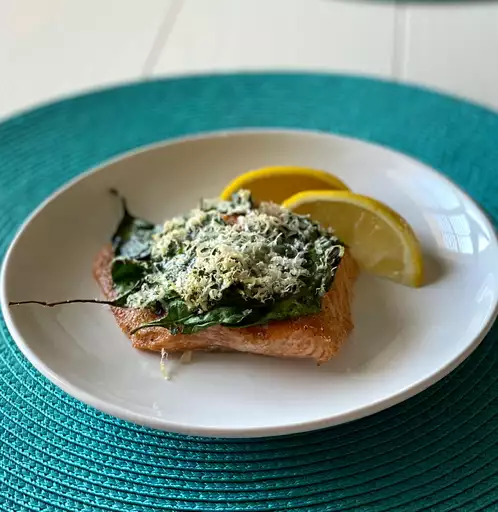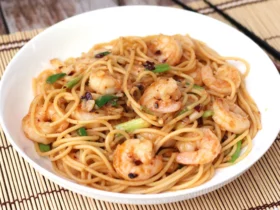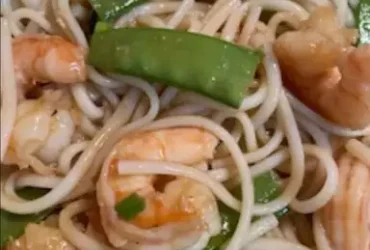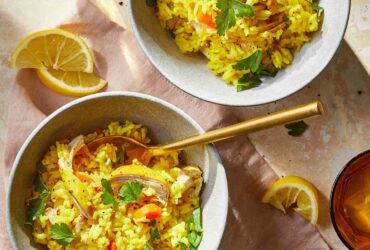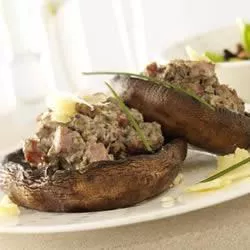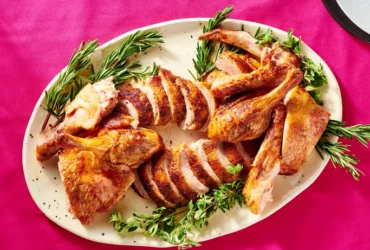Background and History
Baked salmon steak is a classic dish beloved for its simplicity and rich flavor. Salmon has been a staple food for coastal communities for centuries, valued for its high nutritional content and delicious taste. Baking salmon is a popular method that preserves the moisture and tenderness of the fish while infusing it with the flavors of herbs and seasonings. This dish is a perfect blend of healthiness and gourmet appeal, making it a favorite in many households.
Serves
- 2 people
Time
- Total: 30 minutes
Cooking Time
- Preparation: 10 minutes
- Baking: 20 minutes

Ingredients
- 2 salmon steaks (about 6-8 oz each)
- 2 tbsp olive oil
- 2 cloves garlic, minced
- 1 lemon, thinly sliced
- 1 tsp dried dill (or 1 tbsp fresh dill, chopped)
- 1 tsp paprika
- Salt and pepper to taste
- Fresh parsley, chopped (for garnish)
Instructions
Preheat the Oven
Preheat your oven to 400°F (200°C).
Prepare the Salmon
-
- Rinse the salmon steaks under cold water and pat dry with paper towels.
Season the Salmon
- Place the salmon steaks on a baking sheet lined with parchment paper.
- Drizzle olive oil over the steaks.
- Sprinkle minced garlic, dill, paprika, salt, and pepper evenly over both sides of the steaks.
Add Lemon Slices
- Arrange lemon slices on top of and around the salmon steaks.
Bake
- Place the baking sheet in the preheated oven.
- Bake for 15-20 minutes, or until the salmon is cooked through and flakes easily with a fork.
Garnish and Serve
- Remove from the oven and garnish with fresh parsley.
- Serve immediately, pairing with your favorite sides.
Nutrition Facts (per serving)
- Calories: 400
- Protein: 35g
- Carbohydrates: 5g
- Fat: 25g
- Fiber: 1g
- Sodium: 150mg
Notes
Ingredient Substitutions
Fresh herbs like thyme or rosemary can be used instead of dill.
You can substitute olive oil with melted butter for a richer flavor.
Side Dishes
Pair with roasted vegetables, a light salad, or quinoa for a complete meal.
Storage
Leftovers can be stored in an airtight container in the refrigerator for up to 2 days. Reheat gently to avoid drying out the salmon.
Allergy Warning
Fish Allergies
This dish contains fish, which is a common allergen. Ensure that no one consuming this dish has a fish allergy.
Cross-Contamination
Be cautious of cross-contamination if preparing for someone with fish allergies. Use separate utensils and cutting boards.
Enjoy this easy and delicious baked salmon steak recipe, perfect for a nutritious and flavorful dinner for two!
Is it better to bake salmon at 350 or 400?
Baking salmon at 400°F is generally better as it allows the fish to cook faster and develop a slightly crispier exterior while keeping the inside moist and tender. However, baking at 350°F can also be effective if you prefer a more gently cooked, evenly textured salmon.
Should salmon be covered when baked?
Salmon does not need to be covered when baked. Leaving it uncovered helps to develop a slight crust and ensures the fish doesn’t become too steamed. However, covering it with foil can help retain moisture if you prefer a softer texture.
What is the tastiest way to cook salmon?
One of the tastiest ways to cook salmon is by baking it with simple seasonings like olive oil, garlic, lemon, and herbs. This method enhances the natural flavors of the salmon and ensures a moist, flaky texture.
What temperature is salmon steak cooked to?
Salmon steak is perfectly cooked when it reaches an internal temperature of 145°F (63°C). At this temperature, the flesh should be opaque and easily flake with a fork.
When to salt salmon before cooking?
Salt salmon just before cooking to help the flesh retain its moisture and enhance its natural flavor. Avoid salting too far in advance, as it can draw out moisture and lead to a drier texture.
How do I know when salmon is done?
Salmon is done when it flakes easily with a fork and the flesh is opaque. You can also check the internal temperature with a meat thermometer to ensure it has reached 145°F (63°C).
Should you eat salmon skin?
Yes, you can eat salmon skin. It is rich in nutrients and becomes crispy when cooked properly. However, make sure the skin is clean and sourced from high-quality, sustainably-raised salmon.
What happens if salmon is undercooked?
If salmon is undercooked, it may have a translucent appearance and a soft, slightly jelly-like texture. Eating undercooked salmon can pose a risk of foodborne illness, so it’s important to cook it to the proper temperature.
Can salmon be eaten raw?
Yes, salmon can be eaten raw if it is sushi-grade, meaning it has been frozen to kill parasites. Always ensure that raw salmon is sourced from a reputable supplier to minimize the risk of foodborne illness.
Do you need to wash salmon?
No, you do not need to wash salmon before cooking. Washing raw fish can spread bacteria to your sink and kitchen surfaces. Instead, pat the fish dry with paper towels to remove any excess moisture.
- Best LeadsGorilla Alternatives for 2025 - April 22, 2025
- Best Leadzai Alternatives for 2025 - April 22, 2025
- Best LeadSwift Alternatives for 2025 - April 21, 2025

